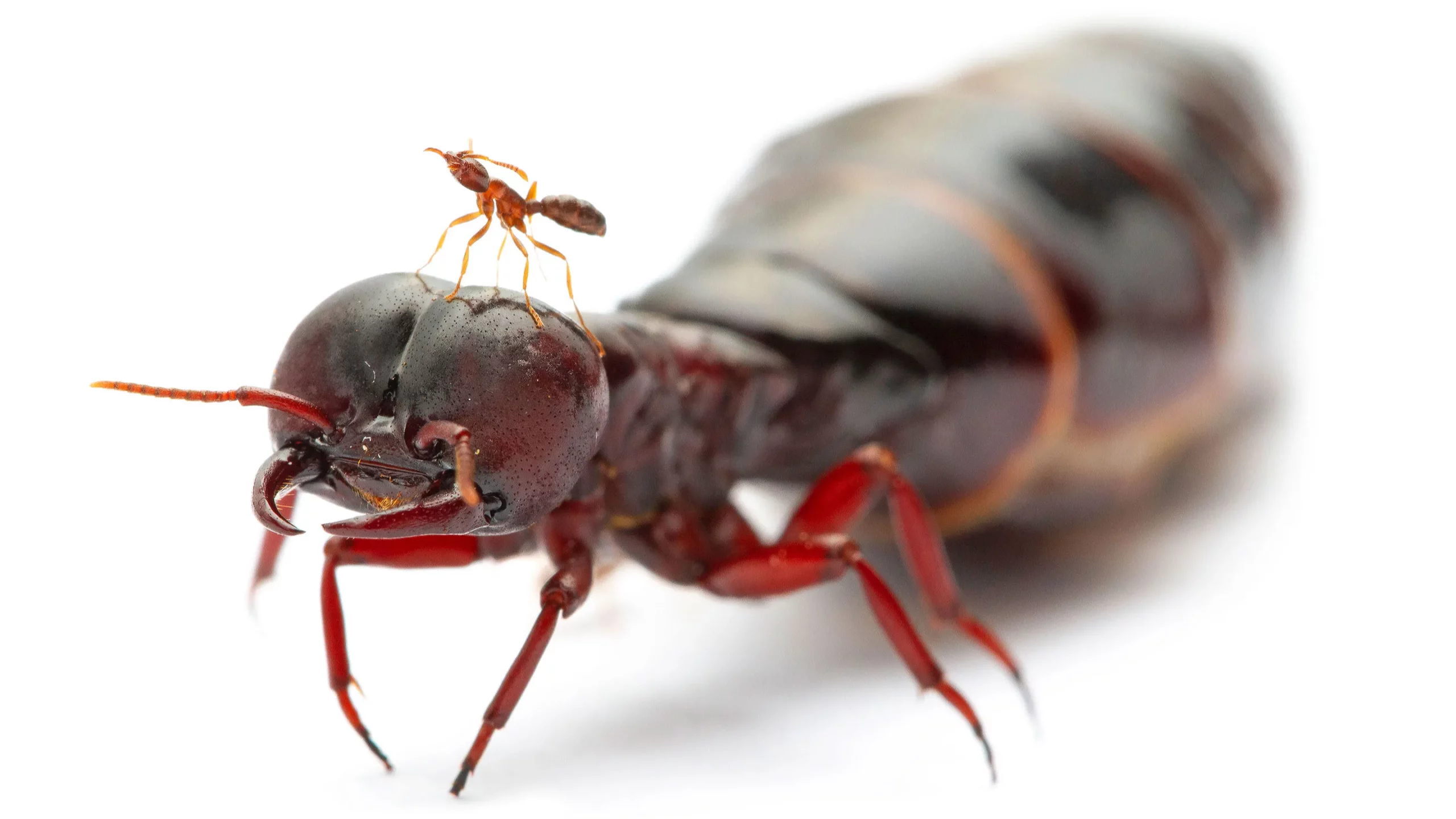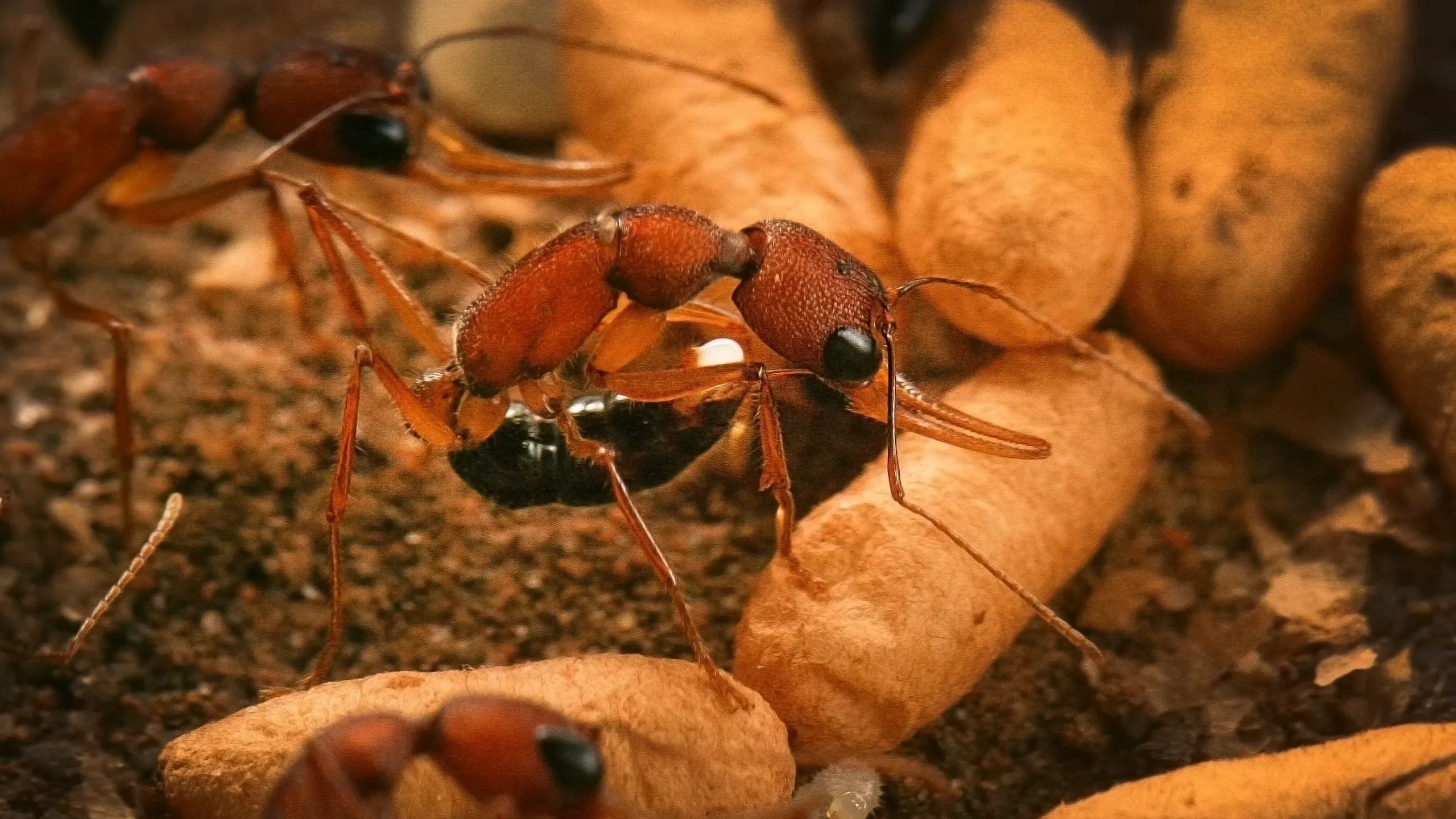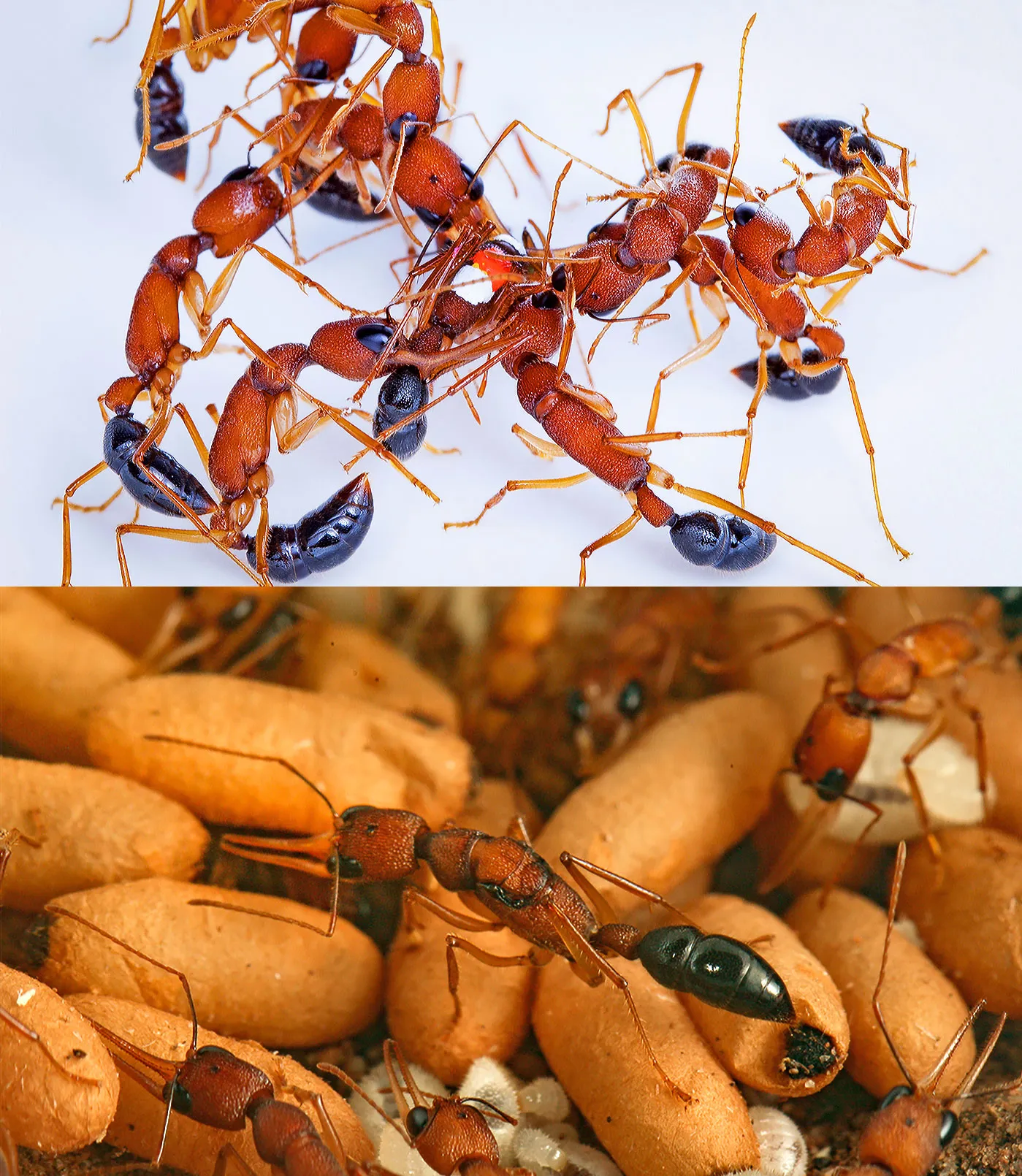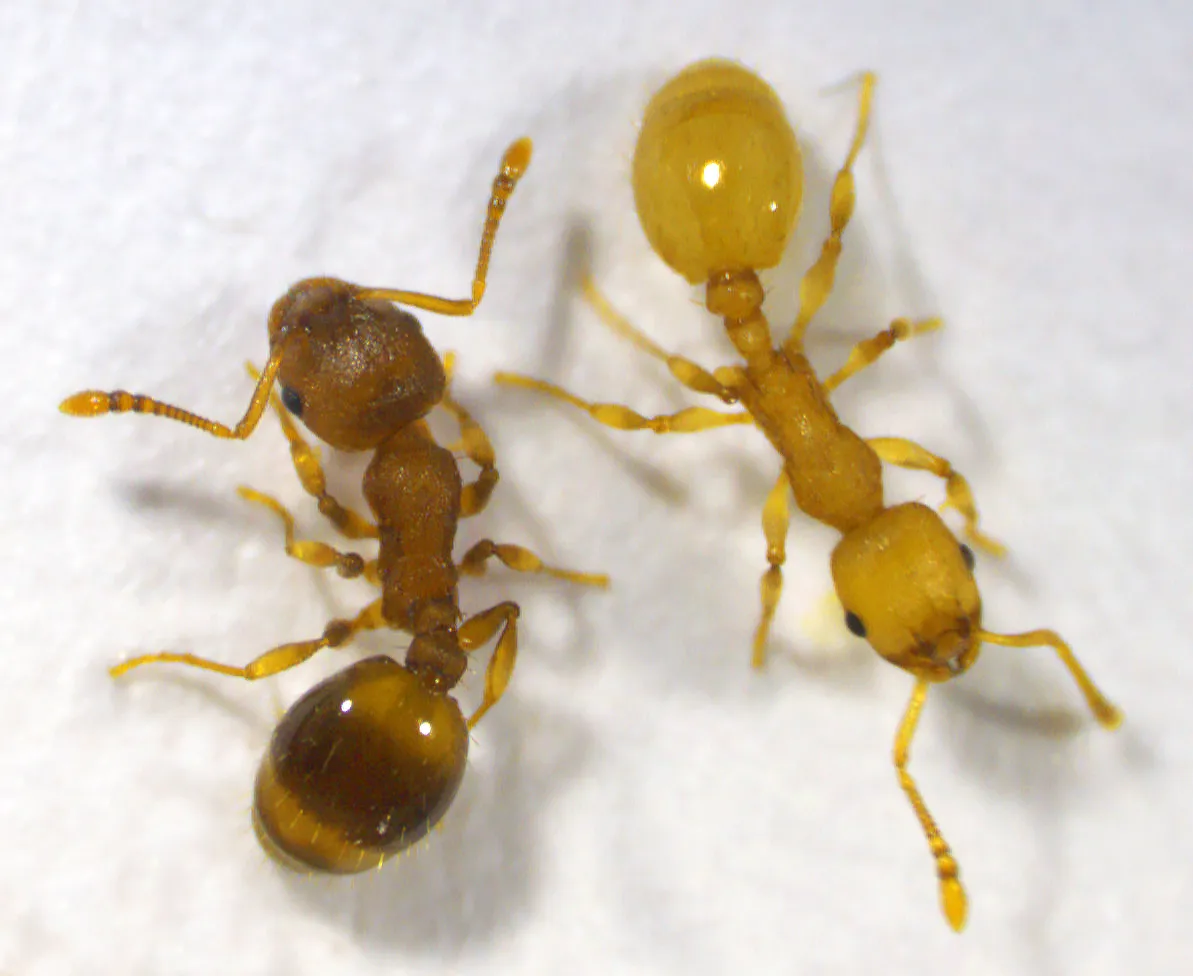Ants Live 10 Times Longer by Altering Their Insulin Responses

These two African driver ants are the same species, Dorylus molestus. The huge queen lays millions of eggs every month and can live for years; the tiny nonreproductive worker may last only for months. Researchers are discovering how ants with the same genes can have such incredibly flexible life spans.
Daniel Kronauer
Introduction
Animals that produce many offspring tend to have short lives, while less prolific species tend to live longer. Cockroaches lay hundreds of eggs while living less than a year. Mice have dozens of babies during their year or two of life. Humpback whales produce only one calf every two or three years and live for decades. The rule of thumb seems to reflect evolutionary strategies that channel nutritional resources either into reproducing quickly or into growing more robust for a long-term advantage.
But ant queens can have it all. In some ant species, queens live more than 30 years while laying the thousands upon thousands of eggs that become all the workers in the nest. In contrast, worker ants, which are females that don’t reproduce, live only months. Yet if circumstances demand it, the workers of some species can step up to become pseudo-queens for the good of the nest — and to reap a significant extension in their life span.
What governs this gigantic range in ant life span is poorly understood, but two recent studies have revealed important details about what makes the life spans of ants so flexible. In Science, researchers at New York University showed that some ant queens produce a protein that suppresses the aging effect of insulin so that they can consume all the additional food needed for their egg-laying without shortening their lives. And in a preprint recently posted on the biorxiv.org server, researchers in Germany described a parasite that greatly lengthens the lives of its ant hosts by secreting a rich cocktail of antioxidants and other compounds. Both studies add to the evidence that the observed life spans of organisms have little to do with limitations imposed by their genes.
“Most studies about aging are done on model organisms which have very short life spans,” said Laurent Keller, a professor of ecology and evolution at the University of Lausanne in Switzerland. Social insects, he explained, offer fascinating opportunities to study the importance of gene expression in aging because the queen and the workers in a colony often have the same genome but differ in their life spans by an order of magnitude. (Two decades ago, Keller showed that ant queens live about 100 times as long as the ancestral solitary insects from which ants evolved.)
And because the workers are short-lived, “you can try to figure out how to make them live longer,” said Arjuna Rajakumar, a postdoctoral fellow who now studies the reproductive constraints on worker ants at the Whitehead Institute at the Massachusetts Institute of Technology, having recently completed his graduate work at McGill University. The exciting possibility is that the metabolic mechanisms extending the lives of the insects might also apply to other species, including humans. “We want to understand how you make something live longer, not [just] why something lives so long,” he said.

This Harpegnathos saltator ant is laying an egg, but it is not a queen, the caste of ant that usually reproduces for the nest. It is instead a gamergate, a worker that has responded to the absence of a queen by becoming reproductive.
Clint Penick
Eating More While Aging Less
For decades, studies have pointed to insulin and the biochemical signaling system that it activates as key regulators of aging. Insulin affects how body cells take up and use the sugar glucose, so it has a fundamental influence on the amount of energy available to cells for growth, reproduction and repair. In the process, it also regulates the generation of potentially harmful free radicals and other oxidizing molecules that are byproducts of metabolism. Many researchers suspect that this is why caloric restriction diets, which keep insulin levels low, seem to extend life span in many species.
Moreover, insulin seems to have added significance for ants. Several years ago, work led by the evolutionary biologist Daniel Kronauer at Rockefeller University showed that changes in how ants respond to insulin seem to have coaxed them to evolve altruistic colonial societies with reproductive queens and nonreproductive workers.
So four years ago, when Vikram Chandra was a graduate student at Rockefeller University studying the differences between ant queens and workers, insulin was very much on his mind. He and Ingrid Fetter-Pruneda, a postdoctoral fellow in the lab at the time, co-led a team that looked at gene expression in seven ant species and concluded that more insulin signaling occurred in the brains of the queens than in the workers. When they injected worker ants with insulin, it activated their dormant ovaries and triggered egg development. According to Kronauer, who oversaw the study, these findings showed that insulin signaling caused the ants to become reproductive.
That discovery laid the foundation for new work conducted as part of a long-term collaboration between the biologists Claude Desplan and Danny Reinberg at New York University. They showed that evolution has rewired some components of the insulin signaling pathway in ants in ways that could explain why the queens live longer.


In its nest, the H. saltator queen usually lays all the eggs needed to keep a colony going. If the queen is lost, a handful of workers become gamergates to handle that job. As shown at top, workers forcibly “police” unneeded gamergates to stop them from laying eggs.
Clint Penick
In its nest at right, the H. saltator queen usually lays all the eggs needed to keep its colony going. If the queen is lost, a handful of workers become gamergates to handle that job. As shown at left, workers forcibly “police” unneeded gamergates to stop them from laying eggs.
Clint Penick
Desplan and Reinberg studied Indian jumping ants (Harpegnathos saltator), whose queens live about five years and whose workers live only about seven months. But in this species, this difference in life span isn’t set in stone. If a queen dies or is removed from the colony, the workers sense the change almost immediately from the disappearance of her scent. Some of them then become “gamergates” (pseudo-queens) that duel for dominance to take her place. Eventually, a handful of victorious gamergates — usually between three and five — jointly take over the queen’s role as the egg-layers for colony. Other workers then “police” any superfluous gamergates, forcibly suppressing them from laying eggs.
The gamergates’ behavior isn’t the only thing that changes, however: They develop functional ovaries and can lay eggs — and their life span extends to three or four years. Because gamergates aren’t as prolific as queens, it usually takes from three to five of them to replace the queen’s output of eggs. If a gamergate is introduced into a colony where a queen is living, the gamergate reverts to being a worker and her life span shortens.
When a worker becomes a gamergate, her metabolism changes. She eats more, and the resulting rise in her insulin levels triggers the development of her ovaries. She uses the food to make lipids that are packaged into the eggs. But from previous studies of insulin and aging, the NYU researchers had expected that greater insulin signaling would be linked to a shorter life span, not a longer one.
The researchers found the answer hiding in the details of insulin signaling. When insulin binds to its receptor on a cell surface, it sets off cascades of reactions inside the cell, including two distinct chemical pathways. One pathway activates an enzyme called MAP kinase and is critical for metabolism and ovary development. The other pathway suppresses a transcription factor that seems to promote a longer life span. To the researchers’ surprise, when they looked at the ovary and the fat body (which is roughly equivalent to the mammalian liver) in gamergates, they found that the MAP kinase pathway was active but the other one was not.
Further work showed that the ovaries of the gamergates strongly expressed a protein, Imp-L2, that ignored the MAP kinase pathway but interfered with the second pathway in the fat body. “This protein appears to have the function of protecting one pathway that allows metabolism, but inhibiting the pathway that leads to aging,” Desplan said.
Other researchers point out that the new study doesn’t definitively show that Imp-L2 affects life span: Desplan and Reinberg didn’t directly test whether activating the protein in workers would make them live longer or if inhibiting it in gamergates would make them die sooner. Such experiments are challenging because they might necessitate injecting the ants with insulin inhibitors for months or years.
Merrill Sherman/Quanta Magazine
Nevertheless, Desplan and Reinberg’s proposal that the ants are manipulating the different branches of the insulin signaling system is “a really plausible, interesting hypothesis,” said Chandra, who is currently a postdoctoral researcher at Harvard University. “If it stimulates more labs to try to test this, that would be very cool.”
Since it’s easier to perform genetic experiments on fruit flies than on ants, Desplan’s team is now seeing if they can extend the life span of Drosophila fruit flies by activating their expression of Imp-L2. Someday, Desplan hopes to try the experiment in mice as well. “We have a lot of exciting work to do,” he said.
The Parasite That Lengthens Life
In a strange twist, nature seems to have already run its own version of a similar experiment in another species. Researchers in Germany recently discovered that a parasitic tapeworm has evolved the ability to manipulate the extreme plasticity of ant life spans to its own advantage.
The tapeworm must spend part of its life inside acorn ants (Temnothorax nylanderi), which get their names from the nests they build inside individual acorns. When the workers go out to forage, they sometimes eat a tapeworm egg and get infected. But to complete its life cycle, the tapeworm also needs to infect a woodpecker, and it gets that opportunity when woodpeckers eat the acorn homes of the ants.
A few years ago, Sara Beros, a student in the laboratory of Susanne Foitzik at the Johannes Gutenberg University of Mainz in Germany, opened some acorn ant nests and made the odd discovery that while all the uninfected workers died during their months of observation, the infected ones didn’t. (The parasitized ants are easy to identify because their color turns from brown to yellow.) When Beros told Foitzik about it, Foitzik recalls thinking, “That’s not possible. Everything dies.” But Beros was insistent, “and so we looked into it properly.”

Two worker ants of the species Temnothorax nylanderi. The one on the right has turned yellow because it is infected with a tapeworm, which also has the effect of extending the ant’s life span.
Susanne Foitzik
In work presented last summer at a meeting of the International Union for the Study of Social Insects and posted just before Christmas on the biorxiv.org preprint server, Foitzik’s team showed that during the tapeworm’s larval stage in ants, it pumps proteins into the ant’s equivalent of blood (hemolymph) that dramatically extend the life span of the worker. Unlike the Indian jumping ants, acorn ants do not normally develop into gamergates, so the parasite’s extension of their lives has no natural precedent.
“The effect is super strong,” Kronauer said. During the three-year experiment, infected workers lived five times as long as uninfected ones and showed mortality rates as low as those of the queens. The parasite’s manipulation extended the life span of workers so much “that basically you can’t distinguish it from a queen’s,” he said.
Although the infected acorn ant workers don’t become reproductive, they do become more queenlike in several respects, Foitzik said: They work less and draw more attentive care from uninfected workers in the colony. If the queen is removed from the nest, they are also the first workers to develop ovaries.
Foitzik and her team found that the tapeworm larvae produce and secrete more than 250 proteins into the hemolymph of the infected ants — enough to make up about 7% of all the circulating proteins. Most of the proteins have not been characterized, but two of them are identifiable as antioxidants. “So it looks like the [tapeworm] is releasing antioxidants into the ant, and this could increase the life span,” she said.
When Foitzik and her team measured changes in gene expression in the parasitized ants, they found that the infected ants were also making more antioxidants. Moreover, the queens and the infected workers were expressing more of a gene called silver, but the uninfected workers were not. Researchers previously linked the silver gene to an extended life span in fruit flies.
Although it’s clear that a suite of developmental and metabolic changes occurs when workers become more queenlike, it’s difficult to tease apart which of the changes is most important for extending life span. Insulin and antioxidants are important, but Keller thinks that many other factors are also likely to play a role. “So I think there would not be a single pathway that would simply explain the difference in life span — you need to change many things, probably,” he said.
Keller thinks that the findings about the parasites are fascinating because parasites typically shorten rather than lengthen life. But in this case, the extension of the ant’s life span also seems to be adaptive for the parasite: The tapeworm needs to persist in the infected ant long enough for a woodpecker to find the acorn and eat it. If the worker dies before then, the tapeworm dies with it. By lengthening the life of the worker by years, the tapeworm improves the odds that a woodpecker will eventually show up. The abundance of antioxidants in the hemolymph may also help tapeworm larvae live as long as their hosts do.
“Here the parasite is exploiting a social host,” Foitzik explained. It would not make sense to parasitize solitary invertebrates because they never live so long. “But in a social insect, where the queens already live in the safety of the nest for 20 years, you can play that kind of trick.”
Correction: January 10, 2023
An earlier version of this article neglected to mention the contributions of Fetter-Pruneda to the study with Chandra on differences in gene expression between ant castes.





